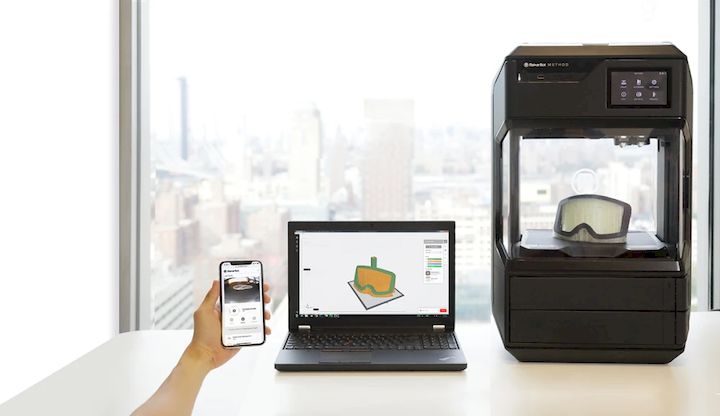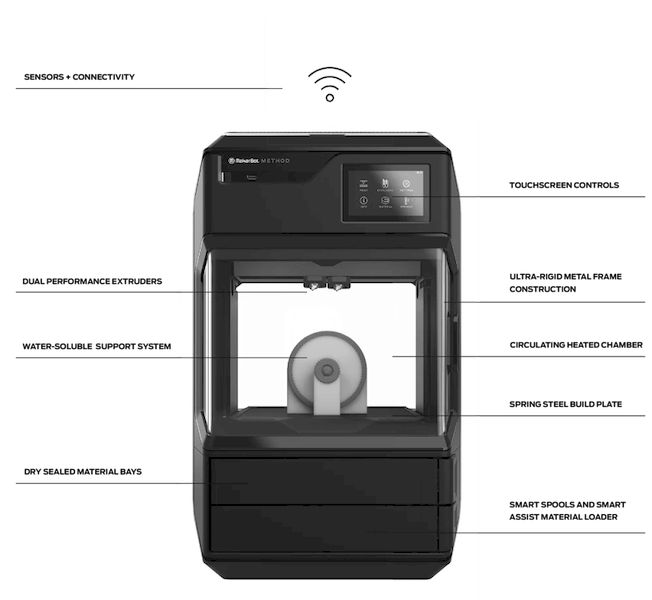
After introducing the original desktop 3D printer to the market in 2009, MakerBot has been on quite a rollercoaster ride including a rocket to global prominence, the launch of a 3D-printable community, an acquisition, the closing of its retail locations, moving from an open- to a closed-source design philosophy, completely redesigning its printers, a lawsuit (against parent company Stratasys), layoffs, the boom and bust of the consumer 3D-printing hype cycle, and cycling through many presidents and CEOs.
Nine years later, the company is in the process of another make(r) over.
Under the leadership of its latest CEO, former MakerBot President Nadav Goshen who took over in 2017, the company is announcing its newest 3D printer, dubbed Method. Will the latest system re-establish the Stratasys subsidiary in the desktop 3D-printing market? We spoke to Goshen, as well as Vice President of Engineering Dave Veisz, to learn more.
From the Replicator to Method
The original MakerBot Replicator, released in 2012, was an open-source, plywood box that users could upgrade and modify to their hearts’ content. By the time Stratasys acquired the startup, the Replicator 2 and 2X had already become a powder-coated steel box and lost its open-source credentials.
Soon, the printer transformed even more toward the industrial look and feel of its parent company with the 5th Generation MakerBot Replicator. After initial issues with a problematic extruder system, the company resolved all of the system’s issues, including the extruder, with the Replicator+, a cloud-run 3D printer capable of printing polylactic acid (PLA) materials.
Since then, MakerBot has continued to increase its market share by 30 percent, according to the company. Goshen pointed out that roughly 7,000 schools and thousands of teachers now use MakerBot 3D printers for educational purposes. While 3D printing with various PLA formulations may be suitable for the classroom, Goshen believed that MakerBot needed to focus not just on education but also on the professional space.

Method is described by the company as “bridg[ing] the gap between desktop and industrial 3D printing” via capabilities only available on industrial machines and at a lower cost. In other words, Method is a system that acts like a Stratasys industrial 3D printer but has the accessibility and a price-point more closely associated with the desktop market: $6,499.
So, what are these features? If you’ve been following the industry for a while, you may have already guessed some, like the heated chamber, dual extruders and water-soluble supports made from polyvinyl alcohol (PVA). Method also features dry-sealed material bays and an ultra-rigid metal frame, as well as built-in sensors and some automation.
Whereas other systems on the market, and even the legacy MakerBot systems, used open-source 3D printers as a starting point and became more industrial, Method seems to use industrial technology as the starting point and reshaped it to be more accessible and affordable.
The Method Behind Method: A Ton of Specs
“When we looked at the professional segment, we saw a very wide gap between industrial and current desktop systems,” Goshen said. “The desktop systems were and still are a result of incremental improvements from the RepRap movement that was launched almost 10 years ago. The movement, and ourselves as one of the leaders of that movement, were able to make something that was very inaccessible accessible and affordable. When we looked at the professional segment, such as industrial designers and engineers, we discovered that what they require is a professional and industrial tool.”
The company describes Method as a system that can be used straight out of the box but with high levels of repeatability and consistency, including parts with ± 0.2 mm dimensional accuracy and “vertical layer uniformity and cylindricity.” MakerBot also claims that Method can print up to twice as fast as other desktop 3D printers, based on internal testing using matching layer heights and infill settings. And, all of this is possible “at one-third of the first-year cost of ownership of an entry-level industrial 3D printer.”
How does Method achieve this? In part by leaning on the patents of its industrial parent company. Get ready for a ton of specs.
According to Dave Veisz, the MakerBot team often had to use 3D-printing service bureaus to produce parts for design work, despite having numerous desktop 3D printers in the office. Veisz explained that key to achieving the dimensional accuracy and consistency necessary for professional applications was controlling the variables that affect print outcome, namely the structural stability and overall environment of the system.
To ensure a rigid machine not easily affected by the vibrations caused by whirling around a dual extruder at high speeds, MakerBot moved away from the traditional approach. Typically, one will find that current desktop systems and older MakerBot models are built from a series of sheet metal panels attached together with nuts and bolts. To attain more rigidity, Method’s body is made up of just a few parts, including a die-cast base. This is meant to offset any flexing that occurs during the printing process. It is designed to improve part accuracy and fewer print failures.
Read more at ENGINEERING.com











A key patent assigned to 3D Systems expires in 2022. What will this mean for 3D Systems and everyone else? We have some thoughts.